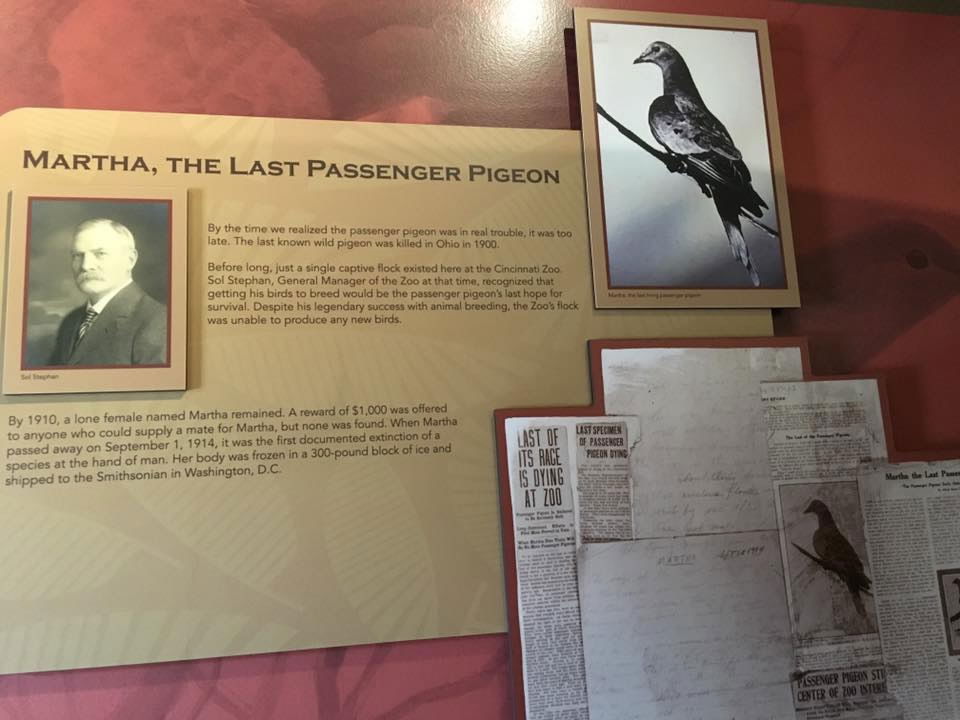Why Bring Back Extinct Species?
Why do scientific research? With every research article I read, I ask that question of myself and the author. Why have they done the research? Why am I interested in learning the results? The way we answer these questions tells us a lot about our worldview.
Let’s look, for example, at the fairly new area of research known as de-extinction. Not too long ago, an article in Scientific American explained that researchers are attempting to take species closely related to extinct species and, using DNA from preserved specimens from institutions like museums and zoological societies, to reincorporate the missing DNA and recreate the extinct species or a close equivalent.1
Based on the article, there are probably two answers to our previous question—Why do scientific research? The primary answer would be that researchers want to see if it is even possible to recreate an extinct species. There are many hurdles to recreating a species, from sequencing the genome of current species, finding genetic samples of extinct species, splicing genes, culturing cells, and incubating and birthing enough specimens for them to continue the species on their own. Each hurdle may take decades to overcome, and that assumes that research money, laboratory space, and researchers are available to pursue the work.
In the article there also appears a secondary motive. In the specific example of the passenger pigeon, researchers want to map out the genetic variations and create a timeline of the bird’s recent evolutionary lineage. Their hope is to better reinforce their worldview by recreating species that could ultimately help them “step back in time” to better define how humans evolved from a single-celled organism, thus voiding their need for God.
As excited as some researchers are about this area of science, others hold that this research is a waste of time and resources, and belongs only in science fiction movies.
As excited as some researchers are about this area of science, others hold that this research is a waste of time and resources, and belongs only in science fiction movies. These researchers question the wisdom of trying to revive species that went extinct for a reason. Organisms of all shapes and sizes have been lost to environmental changes, disease, and lack of nutrition from overcrowding due to destruction of their habitat. Some scientists argue that our time should be spent dealing with these same concerns threatening our current species before trying to resurrect others. The problem is not just being able to regain a single species, but also having to regain the full spectrum of their habitat, including plants, other extinct animals, and anything else that would interact with that species to make its survival plausible. This makes the task seem insurmountable. Their feeling is that the little information gained by these ventures would not warrant the amount of time and energy taken away from today’s conservation movement.2

The Cincinnati Zoo commemorates the extinct passenger pigeon in one of its exhibits.
Do Motives Negate the Value of Research?
Do the motives of the researcher negate the value of the research itself? As Christians, who believe in the Bible and its account of a literal six-day creation approximately 6,000 years ago, does this research contrast or, worse, void our faith? Actually it is quite the opposite. Baraminologists, scientists who study the created kinds of the Bible, have been conducting similar studies on a theoretical level for about as long as the de-extinction researchers have been doing their work.
The area of baraminology has been more widely recognized recently with the opening of the Ark Encounter in Kentucky. Answers in Genesis, the parent organization behind the venture, wanted to relay, as accurately as possible, not only how many animals would have been present on the Ark but also what they may have looked like. These baraminologists have spent research, time, and energy working through decades of historical logs, paleontological records, comparative morphology, and statistical analysis to come up with the answers that are presented as you walk through the Ark Encounter.
Both areas of research are looking for what previous generations of organisms may have been like and how to get to those organisms from the organisms we have presently. Both methods of study are viable means of investigating this question because they both go back to the basic premise of genotype versus phenotype. An individual’s genotype is his entire genetic code. An individual’s phenotype is the result of that genetic code being expressed in proteins, which through billions of interactions create our physical bodies. This is not a one-for-one type of situation. Though every cell in your body carries your complete DNA,3 every cell does not use the body’s entire genome.
In many cases there is not a single gene that programs a single trait.
In many cases there is not a single gene that programs a single trait. Multiple genes work together to create, for example, your hair. Each one of these genes also has options (alleles); you get two options, one from each of your parents. Sometimes one option can hide another option, or they can both be visible as an average of the two, or one may exaggerate the effect of the other. Every individual carries these pieces of—from a physical point of view—hidden information. This is why we have so many different kinds of dogs. As we select genes for certain physical characteristics of dog breeds, we increase the likelihood of only getting certain alleles, and then those individuals no longer have the option of giving some of those previously hidden traits. We have lost information, which may or may not affect the physical appearance of an organism.

Our artists and content team researched decades of historical logs, paleontological records, comparative morphology, and statistical analysis to find the answers presented at the Ark Encounter.
It is the variety of genetic options that allows organisms to survive things like environmental stresses or disease. Situations like this can sometimes create what we call a genetic bottleneck. If there is a severe change or stress on a population, only certain individuals may survive, and they may not represent the full breadth of genetic variety that the population had prior to the external stress. This can lead to a decrease in information rather than an increase in information. The most severe genetic bottleneck in recorded history was when Noah and his family entered the Ark (Genesis 7:7). The entire human population was reduced to the genetic diversity of these eight individuals. There was still plenty of genetic diversity (genotypes) to give us all the people we see today, yet it was limited to only eight phenotypes on the Ark. We may never fully know the loss of genetic diversity that happened during the Flood.

A monument at the Cincinnati Zoo commemorates the extinct passenger pigeon.
With this understanding of genotype versus phenotype, de-extinction and baraminology researchers can work together. The data that they look at is the same for both groups. Both areas of research are investigating the loss of genotypic and phenotypic diversity in today’s world, and devising ways to recreate that biodiversity, be it theoretical or experimental in nature. The difference in interpretation (i.e., de-extinctionists using it to reinforce their evolutionary world view, and baraminologists using it to back up the Biblical account of creation) does not negate the data.
The bigger question is, Which worldview best explains the data? As previously described, this loss of information is what would be expected in a fallen, sin-cursed world, where the opposite—gain of information—would be required for this study to edify the evolutionary worldview. In the case of the pigeons, when the passenger pigeon died out we lost genetic information that was unique to that species, though thankfully there are preserved specimens from which to potentially retrieve any species-specific traits. The pigeon species that are still represented today are not new forms of the passenger pigeon with new information but instead a form of pigeon that does not have the same range of traits to choose from. No new information has been gained.
Are Christians Called to Research Creation?
As creationists, we still have to pose the question, Why as Christians should we spend time, effort, and money to recreate previously extinct species? Will this research help us learn more about God? Will it bring honor and glory to Him? Can it be used for kingdom purposes? Does the Bible have anything to say about this? You will not find a passage in Scripture that says, “Yes, you should study the genetics of an extinct species of pigeon.” However, you will find passages that describe our God-given curiosity about the world around us. This goes all the way back to the second chapter of Genesis.
Out of the ground the Lord God formed every beast of the field and every bird of the air, and brought them to Adam to see what he would call them. And whatever Adam called each living creature, that was its name. So Adam gave names to all cattle, to the birds of the air, and to every beast of the field. But for Adam there was not found a helper comparable to him. (Genesis 2:19–20)
God did not just tell Adam the names of the animals; God gave Adam the chance to explore His creation. In the act of exploring, Adam was also able to learn that he was different from the rest of God’s creation. Likewise, as we explore creation, we learn more about our Creator God. Adam’s discovery that he was unique helps us to understand that being made in God’s image is unique to mankind. Psalm 19:1 tells us, “The heavens declare the glory of God; And the firmament shows His handiwork.” By studying His creation we continue to know God better and, as with any good relationship, getting to know one another better leads to deeper relationships.
By studying His creation we continue to know God better and, as with any good relationship, getting to know one another better leads to deeper relationships.
Scripture also suggests another reason that researching God’s creation is beneficial. In Luke 12:27 Jesus tells us, “Consider the lilies, how they grow: they neither toil nor spin; and yet I say to you, even Solomon in all his glory was not arrayed like one of these.” He is comparing God’s creation to that which man is able to produce. What we create pales in comparison to God’s creation. But what does this have to do with pigeon genetics?
Many of today’s technologies have been inspired and patterned after things found in nature. For example, studying the structure of the lotus leaf has led to discoveries in stain-resistant fabrics. Also the squid’s propulsive forces inspired jet propulsion systems. By studying this pigeon’s genetics and possibly being able to reintroduce the species into today’s current populations, we may be able to open up a plethora of opportunities. What if this research leads to a cure for a disease ravaging today’s society, or to an animal that can thrive in hostile environment to provide a protein source for starving people? What if we find that these birds have a slightly different communication pattern, provoking the next big technological revolution? By reviving lost species we may gain the opportunity to see information that was previously lost to us.
Creation not only allows us to grow in our understanding and relationship with God, but it also allows us to discover new resources to help our fellow man. We live in a fallen word where sin and death affect our every moment. Using our God-given curiosity and sense of exploration, we get a glimpse of the resources God has so richly supplied us with in His creation. These gifts can open doors to share with people how God not only provides for our physical needs but for our spiritual needs as well. Sin is the direst disease on this planet, affecting 100% of humanity. God’s grace through the death, burial, and Resurrection of Jesus is the ultimate discovery in anyone’s life.
No matter if it is pigeon DNA in a sophisticated laboratory, a trip to a zoo or museum, or time spent in your own backyard, let today’s adventure into scientific research reveal to you the Lord Creator, the God of the Bible.
Footnotes
- David Biello, “Ancient DNA Could Return Passenger Pigeons to the Sky,” Scientific American, August 29, 2014, https://www.scientificamerican.com/article/ancient-dna-could-return-passenger-pigeons-to-the-sky/.
- See Paul R. Ehrlich, “The Case Against De-Extinction: It’s a Fascinating but Dumb Idea,” Environment 360, January 13, 2014, http://e360.yale.edu/feature/the_case_against_de-extinction_its_a_fascinating_but_dumb_idea/2726/; and Stuart Pimm, “Opinion: The Case Against Species Revival,” National Geographic, March 12, 2013, http://news.nationalgeographic.com/news/2013/03/130312--deextinction-conservation-animals-science-extinction-biodiversity-habitat-environment/.
- There are two exceptions to this. Mature mammalian red blood cells lose their nucleus and thus all the nucleus’ genetic information. Also, eggs in females and spermatozoa in males contain only half of a person’s genetic information.

Answers in Genesis is an apologetics ministry, dedicated to helping Christians defend their faith and proclaim the good news of Jesus Christ.
- Customer Service 800.778.3390
- Available Monday–Friday | 9 AM–5 PM ET
- © 2026 Answers in Genesis




